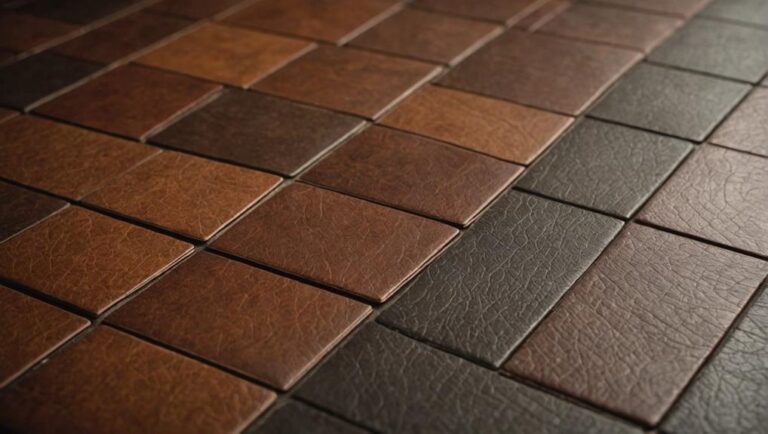To remove winter salt stains from your floors, start by sweeping or vacuuming the area. Create a cleaning solution by mixing equal parts warm water and white vinegar. Spray this on the stained spots and let it sit for 5-10 minutes. Gently scrub the area with a soft cloth or sponge, then rinse thoroughly with clean water to remove any residue. For different floor types, adjust your cleaning method accordingly—avoid saturating hardwood or laminate. Establishing a routine for winter cleaning can help prevent future stains. There's more helpful information to guarantee your floors stay looking their best.
Understanding Salt Stains
When it comes to winter wear and your home, salt stains can be a pesky reminder of the season. These stains primarily originate from the salt composition of the de-icing agents used on roads and walkways. When snow or ice melts, the salt gets transported indoors on your shoes, leaving unsightly marks on your floors that can be tough to eliminate.
Understanding the nature of these stains is essential for effective removal. Salt compounds are hygroscopic, meaning they attract moisture. When they come into contact with your flooring, they can create a chemical reaction that leads to potential stain permanence if not addressed promptly. The longer the salt remains on the surface, the more challenging it becomes to remove the stain entirely.
Different flooring types react differently to salt. For example, hardwood and laminate floors may suffer more damage than tile or vinyl. Knowing your flooring type can help you choose the right approach to tackling these stains without risking further damage.
To prevent salt stains from becoming a permanent fixture, consider implementing a regular cleaning routine during winter months. This can save you from more extensive cleaning efforts later on. By staying proactive and addressing the issue early, you can keep your floors looking great and maintain a safe environment in your home.
Essential Cleaning Supplies
To effectively tackle winter salt stains, having the right cleaning supplies on hand is vital. You'll want to gather a few key items to guarantee you're prepared for the job. Start with a bucket for mixing your cleaning solutions. A clean, soft mop or cloth is essential for applying your chosen solution without scratching your floors.
Next, invest in a pH-neutral cleaner specifically designed for your flooring type. Many commercial cleaning solutions are available, and choosing one that's safe for your floor will help prevent damage. If you prefer a homemade option, a mixture of warm water and white vinegar can be an effective alternative. Just remember, always spot test any solution in an inconspicuous area first.
You'll also need a stiff-bristled brush for scrubbing stubborn stains. This tool can help lift the salt residue without risking damage to your floor's surface. Additionally, don't forget to have plenty of clean water on hand for rinsing the area after cleaning.
Step-by-Step Cleaning Methods
With your cleaning supplies ready, it's time to tackle those winter salt stains head-on. Start by sweeping or vacuuming the area to remove any loose debris. This'll make your cleaning process easier and more effective.
Next, choose an eco-friendly solution to help break down the salt. A mixture of equal parts white vinegar and water is a great option. Pour this solution into a spray bottle for easy application. Spray the stained areas generously, allowing it to sit for about 5-10 minutes. This gives the solution time to penetrate the stain.
After the solution has soaked in, use a soft cloth or sponge to scrub the area gently. Employing these cleaning techniques will help lift the salt without scratching your floors. If you notice stubborn stains, you may want to repeat the spraying and scrubbing process.
Once the stains are lifted, rinse the area with clean water to guarantee all vinegar residue is removed. This step is essential, as leftover vinegar can potentially damage some flooring materials over time.
Preventing Future Stains
Preventing future salt stains is easier than you might think. By making a few simple changes, you can keep your floors looking great all winter long. Here are some practical steps you can take:
- Use Salt Alternatives: Consider using sand or kitty litter instead of traditional salt. These alternatives provide traction without the damaging residue that salt leaves behind.
- Implement Entry Mats: Place heavy-duty mats at all entrances. They'll help trap salt and moisture before it reaches your floors. Make sure to clean them regularly to maintain their effectiveness.
- Apply Protective Coatings: Invest in protective coatings for your floors. These sealants create a barrier that makes it harder for salt to penetrate and stain your surfaces. Just be sure to choose a coating that's safe for your specific floor type.
- Regular Cleaning Routines: Establish a routine for cleaning your floors during winter. A quick sweep or vacuum can eliminate salt before it has the chance to settle in. Follow up with a damp mop using a gentle cleaner to keep your floors fresh.
Tips for Different Floor Types
Even with preventive measures in place, salt stains can still occur on various flooring types. Each type of floor requires a specific approach to effectively remove these stains while guaranteeing the safety of the surface.
For tile floors, a mixture of warm water and mild detergent works wonders. Gently scrub the stained area with a soft brush, then rinse with clean water to avoid residue buildup. For stone tiles, avoid acidic cleaners as they can damage the surface; instead, use a pH-neutral cleaner designed for natural stone.
Hardwood floors require a more delicate touch. Start by lightly dampening a cloth with a hardwood-safe cleaner and gently wipe the stain. Always guarantee your cloth isn't soaking wet to prevent water damage. For laminate flooring, use a similar approach as with hardwood, being cautious not to saturate the surface.
When it comes to carpeted surfaces, blot the stain gently with a cloth dampened in a solution of vinegar and water. Avoid rubbing, as this can damage the fibers. For concrete surfaces, create a paste of baking soda and water, apply it to the stain, let it sit, then scrub with a brush and rinse thoroughly.
Regardless of the floor type, always test any cleaning solution in a small, inconspicuous area first. Following these tips will help keep your floors looking their best while guaranteeing they remain safe and undamaged.
Frequently Asked Questions
Can I Use Vinegar to Remove Winter Salt Stains?
Yes, you can use vinegar to remove winter salt stains. Its effectiveness comes from its acidic properties, which can break down the salt residue. To create a vinegar mixture, combine equal parts white vinegar and water in a spray bottle. Spray it onto the stained area, let it sit for a few minutes, then scrub gently with a soft cloth. Always test a small area first to guarantee it won't damage your flooring.
Are There Any Eco-Friendly Cleaning Solutions for Salt Stains?
When it comes to tackling those pesky salt stains, think of nature as your trusty ally. You can use natural remedies like a mixture of baking soda and water or white vinegar diluted with water. These eco-friendly cleaning solutions are safe for you and the environment. Just apply the mixture, let it sit briefly, and wipe it away. With these cleaning tips, you'll restore your floors without harsh chemicals, keeping your home fresh and safe.
How Often Should I Clean Salt Stains During Winter?
During winter, it's crucial to keep your floors clean from salt stains to maintain their appearance and safety. You should ideally clean the stains at least once a week, but increase frequency if there's heavy snowfall or if you notice more buildup. Following these frequency guidelines helps with winter maintenance and prevents damage. Regular cleaning not only keeps your home looking good but also reduces slipping hazards for you and your family.
Will Salt Stains Damage My Floor Over Time?
Yes, salt stains can damage your floor over time, especially on certain floor materials like wood or tile. If left untreated, salt can cause deterioration and discoloration, leading to costly repairs. To prevent stains, it's crucial to clean them promptly and consider applying protective coatings suitable for your floor type. Regular maintenance and stain prevention are key to keeping your floors in good condition and ensuring they last longer.
Can I Use a Steam Cleaner for Salt Stain Removal?
When it comes to cleaning, "a stitch in time saves nine." You can definitely use a steam cleaner for salt stain removal, as its effectiveness can break down residue. However, take some steam cleaner precautions: verify your floor type is compatible, and test a small area first. This way, you'll avoid any potential damage. Always follow the manufacturer's guidelines to keep your floors safe while achieving a fresh, clean look.




